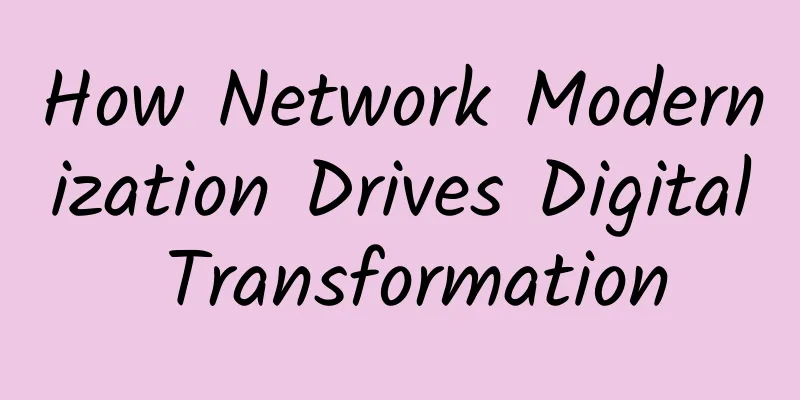The epidemic exposed the network weaknesses. Will you upgrade? Upgrade? Or upgrade?

|
Without any warning, the COVID-19 pandemic forced a large number of employees to start working remotely from home. These employees expect to be able to quickly and reliably access corporate services at home. The pandemic exposed a large number of network infrastructure, planning and management weaknesses, forcing IT managers to urgently adopt countermeasures.
John Annand, director of technology roadmap research at Info-Tech Research Group, said: "As the times change, a large number of workers have quickly dispersed from centralized offices to all corners of the world. This trend has exposed our short-sightedness, cutting corners and slow upgrades in network construction." This has resulted in many companies being unable to use flexible and highly adaptable network technologies during the COVID-19 pandemic. For example, SD-WAN, secure access service edge (SASE) and intent-based networking (IBN). These technologies can improve network availability and agility. Keeping teams across multiple business areas productive is a remarkable achievement for a business. Today, these teams face a new challenge: dealing with potential new security and privacy risks that arise from the hasty deployment of remote work. “The next few months will be critical if companies are to work to mitigate these risks without disrupting the remote working practices that employees have become accustomed to,” said Mike Kavis, chief cloud architect at Deloitte Consulting. Rethinking network architecture One weakness exposed by the pandemic is that most current network infrastructures are designed with employees working in offices. Kowsik Guruswamy, CTO of Menlo Security, a network security technology provider, said: "As many companies began to require employees to work remotely from home, the network became a bottleneck and many employees could not access the resources they needed to do their jobs. In some extreme cases, employees could not even reliably connect to the Internet because all traffic had to flow through a centralized security stack that did not have enough capacity." Enterprises are also having to connect a large pool of remote workers. The problem is that these pools were never designed to handle such high traffic loads. "VPN and network infrastructure have become strained or unable to cope," said Charles Nebolsky, director of network practice at enterprise consulting firm Accenture Technology. "But now is a good time for enterprises to evaluate their network architecture." The situation is exacerbated by the surge in the use of bandwidth-intensive technologies such as video streaming. “That means both lowering latency and reducing jitter,” said Rohit Mehra, vice president of network infrastructure at research firm IDC. “When users are doing things like live video calls or watching training videos, they want a good streaming experience and they want the streaming to be normal.”
However, this is often not the case. The constant flow of unexpected traffic has exposed the shortcomings of many once highly reliable enterprise network architectures. "In order to meet urgent needs and keep the business running, many details are often overlooked," Kavis said. For example, users have little time to test whether the existing network architecture is reasonable or configured correctly to safely accommodate such high traffic for several hours a day. Companies that have chosen SD-WAN and SASE solutions can connect remote workers in a secure and manageable way. “Those that haven’t chosen these solutions may want to explore this,” Kavis noted. Bob Laliberte, senior emerging network technology analyst at research firm ESG, said SD-WAN is an option for some companies that want better performance and security than a VPN. “The ability to centrally manage the environment and ensure that all employees across the company are able to execute company policies is a significant benefit,” he noted. “In addition, companies are able to ensure that employees are making application performance a priority.” Laliberte also noted that SD-WAN can be tightly integrated with security technologies, allowing deployers to leverage both on-premises and cloud-based security capabilities as part of their overall protection. Despite its many benefits, not everyone is buying into SD-WAN to connect employees working from home. “SD-WAN solutions for remote work are expensive and require optimizing traffic or adding network connections for each employee, which is not on the same level of convenience as improving WAN resiliency for a grocery store or acute care center, which is more important because a connection outage or degradation directly affects revenue or customer experience,” explained Andre Kindness, a principal analyst at Forrester who specializes in infrastructure and operations. “Basically, if you apply SD-WAN to remote work, the cost of the solution, implementation, and operational costs may outweigh the benefits.” As an alternative to SD-WAN, Accenture's Nebolsky suggests users consider SASE. SASE is a network fabric that provides cloud-native security features, such as secure web gateways, cloud access security brokers, firewalls and zero-trust network access. "SASE's native ability to scale up and down in the cloud is also worth noting," Nebolsky said. Currently, some enterprises are rapidly increasing their interest in SASE vendors because they hope that the security of remote work can be better protected. Sanjay Uppal, senior vice president and general manager of VMware's VeloCloud business unit, said that the company's SASE network usage has increased fivefold after the outbreak. Mike Wood, chief marketing officer of Versa Networks, said that in late March, remote user traffic increased eight to nine times. Agile and automated network The pandemic has made IT leaders realize that they need both agility and adaptability because they don’t know when normal operations will be thrown into chaos. “These core capabilities need to be applied to all aspects of the business, including data center teams that manage workflows,” said Mike Perera, general manager of technology support services at IBM Services. Perera recommends bringing more automation into data centers to reduce or even eliminate the need for technicians to enter data center sites for capacity expansion or routine work during the COVID-19 pandemic. “From a support perspective, this may require the deployment of tools such as remote augmented reality (AR) to achieve this,” he said.
End-to-end automation (hyperautomation) is the goal of IT automation. Through a variety of technologies such as artificial intelligence (AI) and machine learning (ML), enterprise systems can run more smoothly while reducing the need for on-site personnel. Nebolsky said: "Hyperautomation can also accelerate the company's current automation investment and make the system more resilient. After eliminating application and infrastructure bottlenecks and freeing up labor, enterprises can devote their energy to solving higher priority problems." As automation is widely adopted, more and more companies are migrating to the cloud. Nebolsky explained: "By increasing automation, companies can quickly start a very tight innovation cycle if they want to get ahead in the future." IT leaders believe that this will be a goal in the next decade, and now is the key to development in the next three years. "In the post-epidemic era, occupying the market means entering the market first." Jason Viera, CTO of Carousel Industries, an IT, cloud and managed services provider, suggests that companies should also start looking at ways to simplify their data centers. “Going down the hyperconvergence path can help them achieve that goal.” Hyperconvergence has been gaining attention before the COVID-19 pandemic. More and more IT leaders have realized that in an environment where IT staff may be forced to work from home for a long time, the best way to ensure uninterrupted operations is to establish a hyperconverged infrastructure (HCI). HCI allows enterprises to deploy simplified data centers defined by software. Its main feature is the tight integration of computing, storage, network and virtualization resources that can be accessed anytime and anywhere. Paul Lariviere, technical director of network security consulting firm Security Compass, pointed out: "Almost all software and network-related maintenance work can be done remotely with the appropriate tools." Using a fully managed cloud environment like AWS Outposts can reduce the burden on IT teams while reducing the need for on-site personnel. "Public cloud services like AWS can reduce the workload associated with managing physical equipment," said Menlo Security's Guruswamy. "This allows users to reallocate those resources to ensure software and services are running properly." As new technologies and approaches emerged, it became clear that data center operating models needed to be reevaluated to adapt to changing realities. Network service deals in particular needed to be reexamined. “When we went from 10% to 80% of our workforce working remotely in a short period of time, we realized that our host-to-network connectivity technology didn’t scale very well,” Annand says. “At the same time, we found that the capacity assumptions that we had based our five-year contracts on had changed, locking the company into the services we had signed.” To replace cumbersome VPN-based connections, enterprises are turning to perimeter software-definable functions. Annantd said: "In a zero-trust architecture, users are redirected to the cloud edge for authentication and resource authorization. This approach provides enterprises with the flexibility and scale they need to respond to dramatic changes in network traffic patterns." Remote work for data center and network teams Most IT leaders are looking at how to prepare for the challenges ahead. "I expect that as organizations begin to modify their business continuity plans to address the reality of the global spread of the coronavirus, those responsible for data center operations will be able to work remotely as much as possible," Laliberte said.
However, operations such as installing hardware, establishing connections and replacing defective equipment will continue to require employees to be in the data center. “After this is over, I think we will look at some new ways of working that combine on-site and remote capabilities,” Kavis said. To maintain data center operability and performance levels, remote IT team members need access to management tools that allow them to see the entire network environment, preferably with a single pane of glass. Achieving this will take some work. "We need to keep in mind that few employees will have an operations center at home, and two or three monitors is optimal," Laliberte said. Kavis believes that in some areas, the largely remote workforce is more productive than the pre-pandemic on-site workforce, likely thanks to an increase in the deployment of messaging, video conferencing, collaboration and online tools. For IT, this means now is a good time to adapt to the new reality. Laliberte said: "Enterprises have done a great job responding quickly to the rapidly changing environment, and employees have kept up, learning how to use collaboration tools and maintain productivity during remote work. For many companies, the biggest question is: Do they want to go back to the old working model after the epidemic is over?" |
<<: 5G interface protocol: from CPRI to ECPRI
Recommend
What impact will the cancellation of data roaming have on telecom operators?
With the development of economy and society, the ...
Huawei launches the next-generation CloudLink collaborative telepresence to connect time and space and change the future
[Beijing, China, September 6, 2018] Huawei held t...
Three major challenges faced by enterprise infrastructure modernization
Currently, business development often leads to a ...
Big data architecture, use cases and benefits in IoT
1. Introduction In recent years, the "Intern...
SpartanHost Seattle E5 series VPS restock, 10Gbps port, NVMe hard drive, 20% off monthly payment
SpartanHost's DDoS Protected SSD E5 KVM VPS -...
EtherNetservers: Los Angeles VPS hosting starting from $12/year, supports Alipay/PayPal
In the past two years, fewer and fewer merchants ...
5G spectrum technology has made a breakthrough, and battery life has soared
Improving battery life has been a challenge for a...
BICS: 5G device connectivity unlocks new IoT use cases
BICS, a global voice operator and mobile data ser...
DiyVM: Hong Kong dedicated server from 499 yuan/month, Japan/Hong Kong CN2 VPS from 50 yuan/month
Continue to share DiyVM product information. Curr...
HostXen recharges 300 yuan and gets 50 yuan / recharges 618 yuan and gets 150 yuan, Hong Kong 2G memory VPS monthly payment starts from 50 yuan
HostXen is a DIY-configurable cloud hosting platf...
The UK invests £1 billion to build a full-fiber network, and 5G and ultra-fast broadband will soon benefit 2 million households
[[177138]] In the near future, 2 million househol...
5G may be just around the corner as a universal core for fiber
Convergence between wired and wireless networks i...
Manually sending packets only handshakes twice, I discovered the secret of TCP
[[399328]] Planet Questions There are at least 9,...
"Have you eaten?" | A tragic experience of a message
[[405615]] After get off work, you feel empty and...
The basics of the commonly used mainstream dynamic routing protocol OSPF and OSPF message types. Learn about them in one minute
1. Basic Concepts of OSPF OSPF is based on IP pro...









